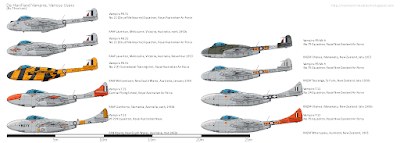The de Havilland Vampire ir a British jet fighter developed and manufactured by the de Havilland Aircraft Company. It was the second jet operated by the Royal Air Force (RAF), but it was also exported all around the world. In this post we're covering the Oceanian users of the Vampire:
- Australia: In 1945 the Royal Australian Air Force (RAAF) decided that their first jet-powered fighter would be a variant of the Vampire built by the Commonwealth Aircraft Corporation (CAC) and powered by the Rolls-Royce Nene engine which would also be manufactured under license in Australia.
After the acquisition of three Vampires Mk.1 from the RAF to gain jet-aircraft experience, on 29th June 1949 the first CAC F.30 flew for the first time. This was followed by a total of 56 machines delivered to the RAAF between September 1949 and July 1952. In March 1952 No.2 Operational Training Unit (OTU) was formed as a jet-training unit at Williamtown, New South Wales.
Nos. 75 and 76 Squadrons were formed in May 1952 as part of No. 78 Wing RAAF based at Williamtown. In July that unit was moved to Malta to support home-based units involved in the Middle-East crisis, this time, however with Vampires loaned by the RAF so the RAAF didn't have to commit their new aircraft.
The next batch of 23 Australian-built Vampires were known as F.31 (AKA FB.31), with 28 additional machines started as F.30 but upgraded to F.31 during manufacturing process. This F.31 variant had strengthened and clipped wings and was introduced during 1956. During October 1951 two F.30 were tested for a hypothetical FB.32 variant with enlarged air intakes and ejection seat. This project was, however, cancelled after one year and a half. During 1955-1956 around 54 F.31 were converted to target-tugs and painted with yellow and black diagonal bands on every surface.
In 1961 the Vampire was withdrawn from service with the RAAF and most were scrapped, used as ground instructional frames or sold to private owners.
Back in 1951 the RAAF ordered 36 Vampire T.33 trainers, which was the Australian equivalent to the T.11. The last T.33 was modified to incorporate ejection seats, clear-view canopy, increased fuel capacity and dorsal fairings. A total of 68 T.33 were ordered in 1955. Some T.33 were retrofitted with those new features and received the denomination of T.35A.
The final RAAF Vampire sortie took place on 18th September 1970 after 18 years in service.
The Royal Australian Navy (RAN) ordered some all-weather Sea Venoms (a much improved version of the Vampire) and, in order to provide dual training, they acquired five T.33 from the RAAF. They were re-designated as Vampire T.34 and were delivered between 1954 and 1958. They were all modified to T.35A standard and were designated as T.34A. All RAN Vampires were kept in service until 5th October 1970. - New Zealand: During the post-war years, the Royal New Zealand Air Force (RNZAF) was undergoing a modernization process, for which they ordered 18 Vampire FB.52 (the export variant given to the FB.6). These machines, built at Chester by Fairey Aviation, were delivered between October 1950 and August 1951. No. 14 Squadron RNZAF, with base at Ohakea, was the first one to operate the Vampire.
Six additional T.55 machines were ordered in 1951 and were delivered between July and December 1952. These were of the earlier type with framed canopy and no ejection seats. Eight additional FB.52 were ordered in 1952, but it was cancelled as the need was filled by refitting eight ex-RAF FB.Mk.5 machines which were delivered between July and September 1953.
Being part of the Commonwealth Strategic Reserve, No. 14 Squadron was rebased to Cyprus on 7th October 1952. Their FB.52 were handed over to No. 75 Squadron and, when based in Cyprus, they received on loan 29 FB.Mk.9 machines. They also employed the T.11. This unit was also deployed to RAF Tengah, in Malaya to support in 1955 'Operation Firedog'. Those Vampires were replaced by Venoms Mk.1 in November 1955.
The New Zealand Territorial Air Force (NZTAF) had three squadrons equipped with the North-American P-51 that were to be replaced by the Vampire in 1955. However, this implied the need for a jet-trainer so, that same year five more ex-RAF T.11s were bought. Those were improved models with clear-view canopy and ejection seats and were delivered between December 1955 and September 1956.
In order to perform single-seat training, 21 additional Vampire FB.Mk.5 were ordered. Those machines were shipped together with some sets of FB.Mk.9 wings to allow retrofitting
During 1955-1956 the RNZAF bought four additional Vampires Mk.1, Mk.3 and Mk.9 to be used as ground instructional frames. During this time 23 RNZAF Vampires were withdrawn from service to be used as ground frames too.
NZTAF was disbanded in 1957 and No. 75 Squadron was re-equipped with the English Electric Canberra, so a lot of Vampires were no longer needed and were put into storage. Some few of them flew with the Fighter Operational Conversion Unit (FOCU) until June 1958 when it was disbanded but, it operated de facto until early 1960.
This unit was replaced by the Bomber Operational Conversion Unit (BOCU) and they operated two Vampire FB.Mk.5 and six T.11 for training and co-operation duties.
No.75 Squadron returned from RAF Tengah in March 1962 and was established with 8 FB.Mk.5 and four T.11 to provide the same training as the BOCU, which was disbanded shortly after.
Some few Vampires were still used until 15th December 1972, when they were finally, flown to depot at RNZAF Woodbourne, Blenheim.
Sources:
1st https://en.wikipedia.org/wiki/De_Havilland_Vampire
2nd Hall Park Books - Warpaint 27 - De Havilland Vampire


No comments:
Post a Comment